Employee Engagement Report: Analysis for Executive Team Briefing
VerifiedAdded on 2022/11/29
|17
|5191
|420
Report
AI Summary
This report provides a comprehensive analysis of employee engagement, differentiating it from related concepts like organizational commitment, job involvement, and job satisfaction. It explores the principal dimensions and components of employee engagement, emphasizing its importance in achieving positive business outcomes. The report identifies key drivers and business benefits of having an engaged workforce, such as improved customer service, reduced employee turnover, and effective decision-making. Furthermore, it outlines various strategies for creating a culture of employee engagement, including job design and offering autonomy. The report also discusses the importance of aligning employee engagement with organizational strategic intent and evaluates diagnostic tools for measuring engagement effectiveness, ultimately providing insights into how businesses can foster a more engaged and productive workforce.
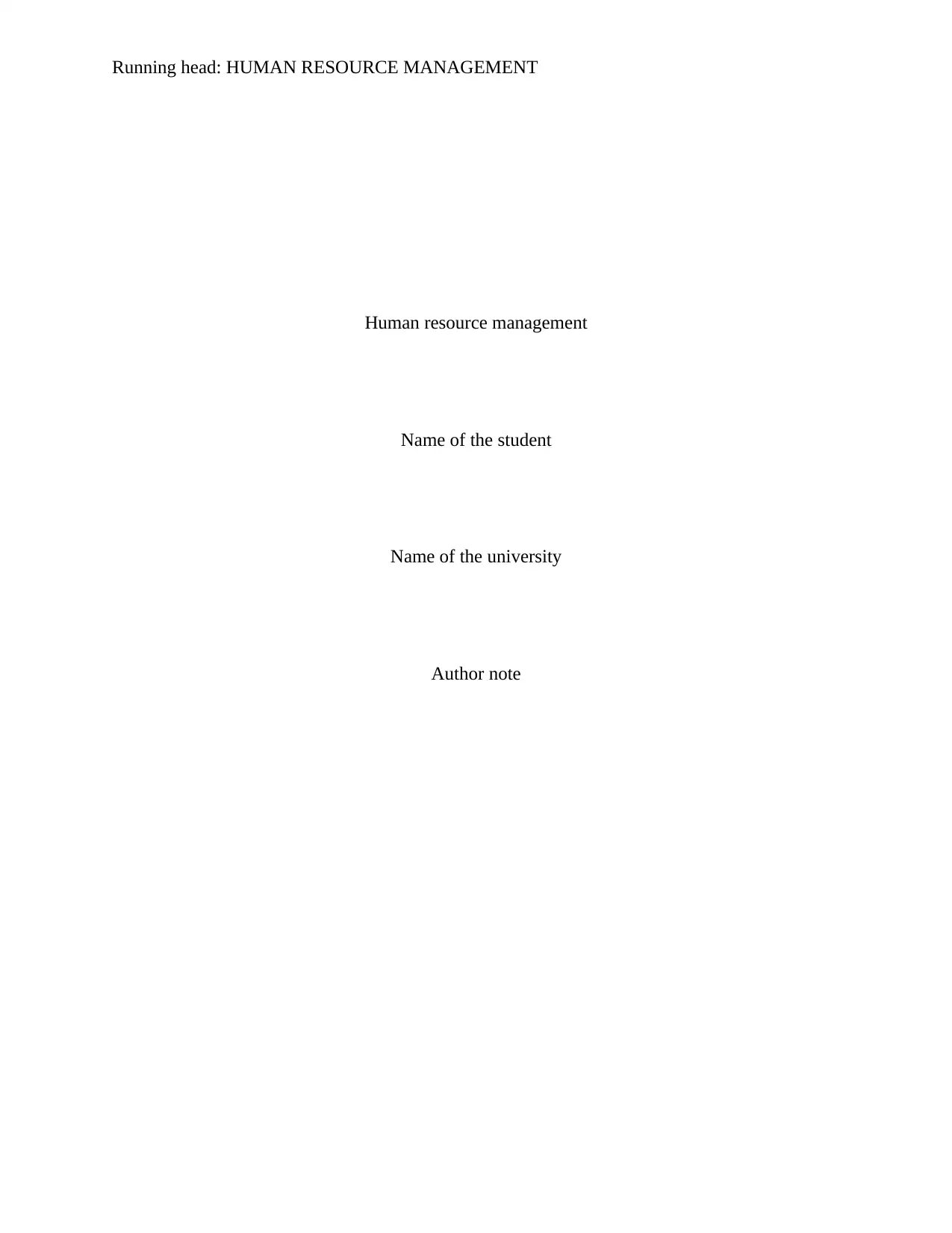
Running head: HUMAN RESOURCE MANAGEMENT
Human resource management
Name of the student
Name of the university
Author note
Human resource management
Name of the student
Name of the university
Author note
Paraphrase This Document
Need a fresh take? Get an instant paraphrase of this document with our AI Paraphraser
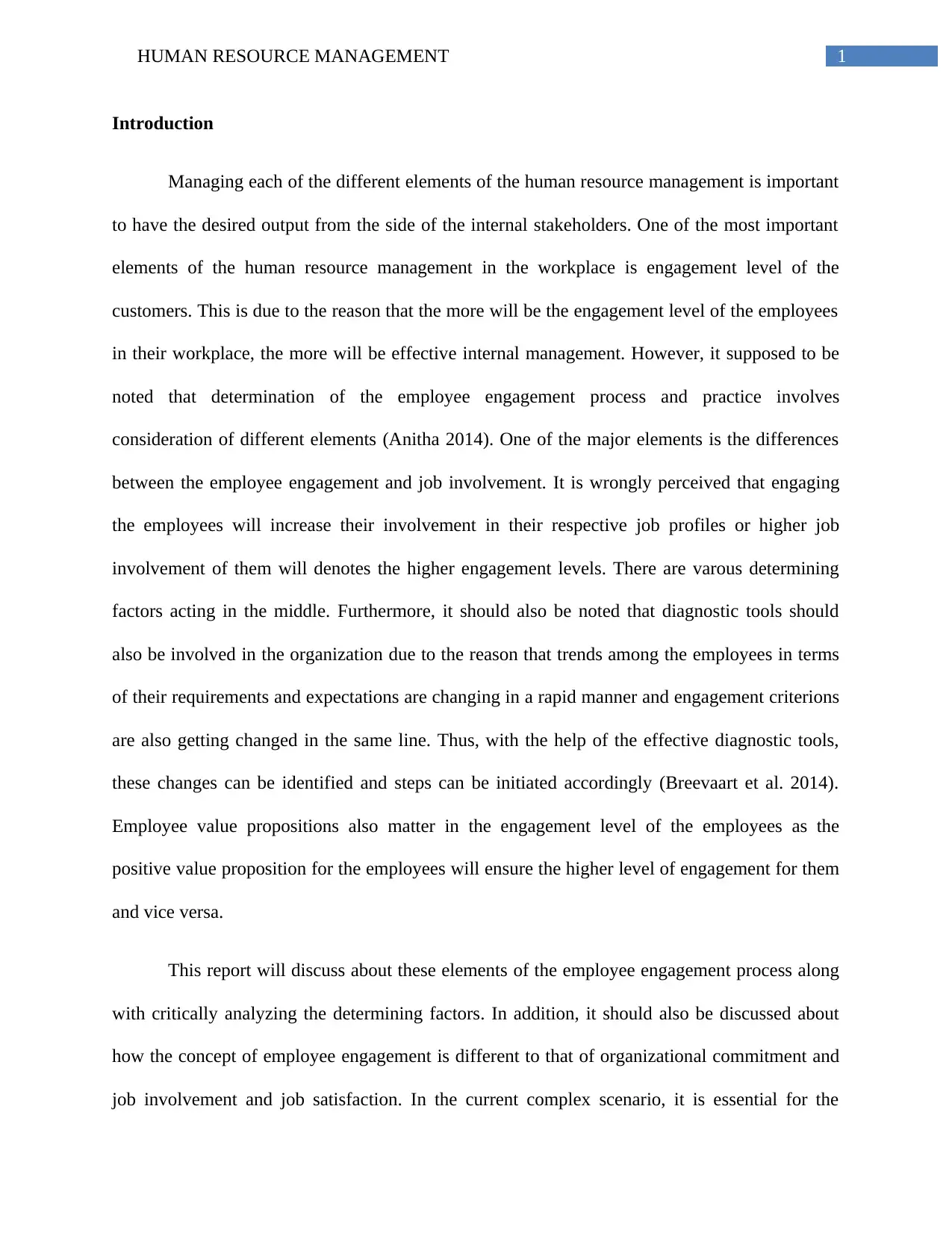
1HUMAN RESOURCE MANAGEMENT
Introduction
Managing each of the different elements of the human resource management is important
to have the desired output from the side of the internal stakeholders. One of the most important
elements of the human resource management in the workplace is engagement level of the
customers. This is due to the reason that the more will be the engagement level of the employees
in their workplace, the more will be effective internal management. However, it supposed to be
noted that determination of the employee engagement process and practice involves
consideration of different elements (Anitha 2014). One of the major elements is the differences
between the employee engagement and job involvement. It is wrongly perceived that engaging
the employees will increase their involvement in their respective job profiles or higher job
involvement of them will denotes the higher engagement levels. There are varous determining
factors acting in the middle. Furthermore, it should also be noted that diagnostic tools should
also be involved in the organization due to the reason that trends among the employees in terms
of their requirements and expectations are changing in a rapid manner and engagement criterions
are also getting changed in the same line. Thus, with the help of the effective diagnostic tools,
these changes can be identified and steps can be initiated accordingly (Breevaart et al. 2014).
Employee value propositions also matter in the engagement level of the employees as the
positive value proposition for the employees will ensure the higher level of engagement for them
and vice versa.
This report will discuss about these elements of the employee engagement process along
with critically analyzing the determining factors. In addition, it should also be discussed about
how the concept of employee engagement is different to that of organizational commitment and
job involvement and job satisfaction. In the current complex scenario, it is essential for the
Introduction
Managing each of the different elements of the human resource management is important
to have the desired output from the side of the internal stakeholders. One of the most important
elements of the human resource management in the workplace is engagement level of the
customers. This is due to the reason that the more will be the engagement level of the employees
in their workplace, the more will be effective internal management. However, it supposed to be
noted that determination of the employee engagement process and practice involves
consideration of different elements (Anitha 2014). One of the major elements is the differences
between the employee engagement and job involvement. It is wrongly perceived that engaging
the employees will increase their involvement in their respective job profiles or higher job
involvement of them will denotes the higher engagement levels. There are varous determining
factors acting in the middle. Furthermore, it should also be noted that diagnostic tools should
also be involved in the organization due to the reason that trends among the employees in terms
of their requirements and expectations are changing in a rapid manner and engagement criterions
are also getting changed in the same line. Thus, with the help of the effective diagnostic tools,
these changes can be identified and steps can be initiated accordingly (Breevaart et al. 2014).
Employee value propositions also matter in the engagement level of the employees as the
positive value proposition for the employees will ensure the higher level of engagement for them
and vice versa.
This report will discuss about these elements of the employee engagement process along
with critically analyzing the determining factors. In addition, it should also be discussed about
how the concept of employee engagement is different to that of organizational commitment and
job involvement and job satisfaction. In the current complex scenario, it is essential for the
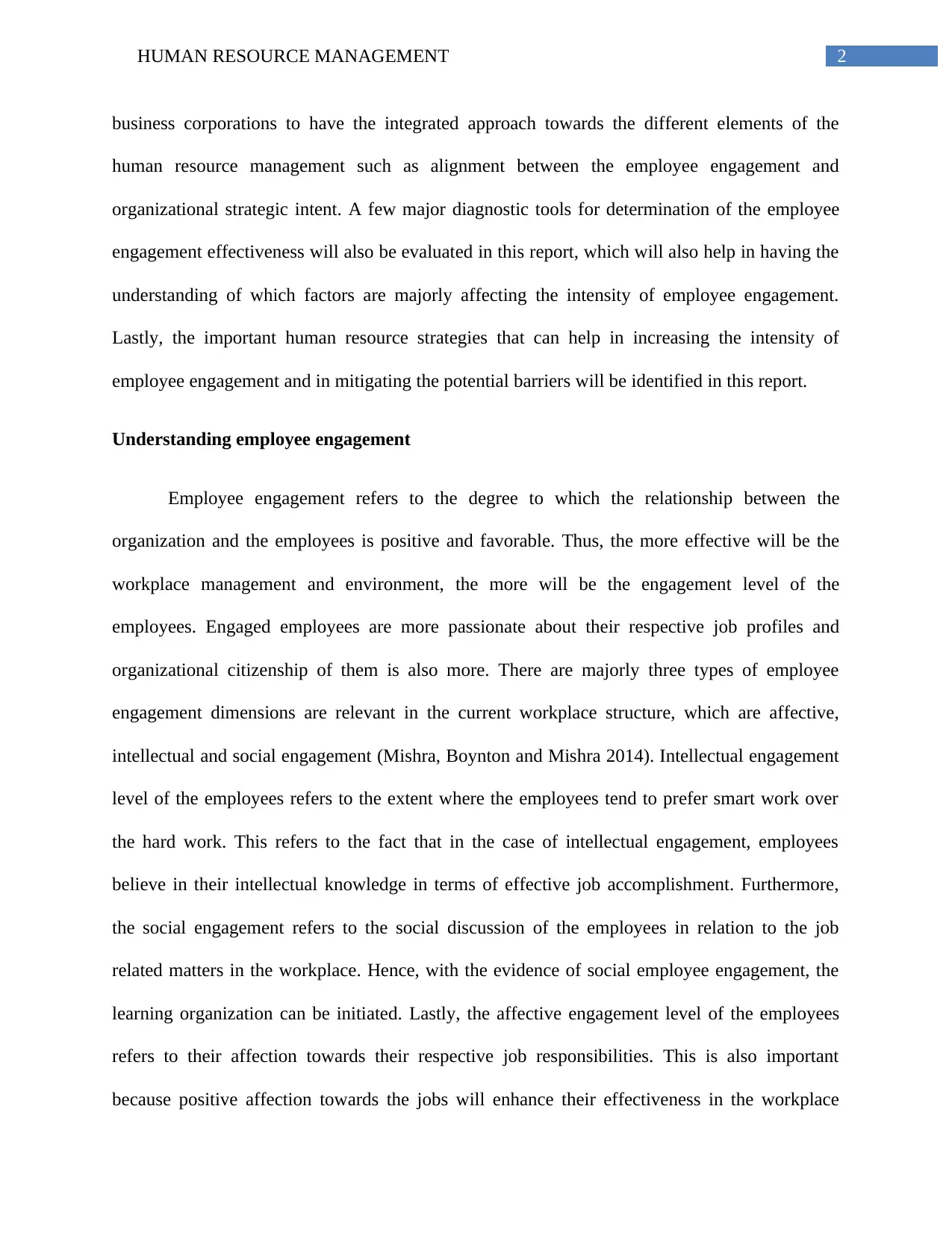
2HUMAN RESOURCE MANAGEMENT
business corporations to have the integrated approach towards the different elements of the
human resource management such as alignment between the employee engagement and
organizational strategic intent. A few major diagnostic tools for determination of the employee
engagement effectiveness will also be evaluated in this report, which will also help in having the
understanding of which factors are majorly affecting the intensity of employee engagement.
Lastly, the important human resource strategies that can help in increasing the intensity of
employee engagement and in mitigating the potential barriers will be identified in this report.
Understanding employee engagement
Employee engagement refers to the degree to which the relationship between the
organization and the employees is positive and favorable. Thus, the more effective will be the
workplace management and environment, the more will be the engagement level of the
employees. Engaged employees are more passionate about their respective job profiles and
organizational citizenship of them is also more. There are majorly three types of employee
engagement dimensions are relevant in the current workplace structure, which are affective,
intellectual and social engagement (Mishra, Boynton and Mishra 2014). Intellectual engagement
level of the employees refers to the extent where the employees tend to prefer smart work over
the hard work. This refers to the fact that in the case of intellectual engagement, employees
believe in their intellectual knowledge in terms of effective job accomplishment. Furthermore,
the social engagement refers to the social discussion of the employees in relation to the job
related matters in the workplace. Hence, with the evidence of social employee engagement, the
learning organization can be initiated. Lastly, the affective engagement level of the employees
refers to their affection towards their respective job responsibilities. This is also important
because positive affection towards the jobs will enhance their effectiveness in the workplace
business corporations to have the integrated approach towards the different elements of the
human resource management such as alignment between the employee engagement and
organizational strategic intent. A few major diagnostic tools for determination of the employee
engagement effectiveness will also be evaluated in this report, which will also help in having the
understanding of which factors are majorly affecting the intensity of employee engagement.
Lastly, the important human resource strategies that can help in increasing the intensity of
employee engagement and in mitigating the potential barriers will be identified in this report.
Understanding employee engagement
Employee engagement refers to the degree to which the relationship between the
organization and the employees is positive and favorable. Thus, the more effective will be the
workplace management and environment, the more will be the engagement level of the
employees. Engaged employees are more passionate about their respective job profiles and
organizational citizenship of them is also more. There are majorly three types of employee
engagement dimensions are relevant in the current workplace structure, which are affective,
intellectual and social engagement (Mishra, Boynton and Mishra 2014). Intellectual engagement
level of the employees refers to the extent where the employees tend to prefer smart work over
the hard work. This refers to the fact that in the case of intellectual engagement, employees
believe in their intellectual knowledge in terms of effective job accomplishment. Furthermore,
the social engagement refers to the social discussion of the employees in relation to the job
related matters in the workplace. Hence, with the evidence of social employee engagement, the
learning organization can be initiated. Lastly, the affective engagement level of the employees
refers to their affection towards their respective job responsibilities. This is also important
because positive affection towards the jobs will enhance their effectiveness in the workplace
⊘ This is a preview!⊘
Do you want full access?
Subscribe today to unlock all pages.

Trusted by 1+ million students worldwide
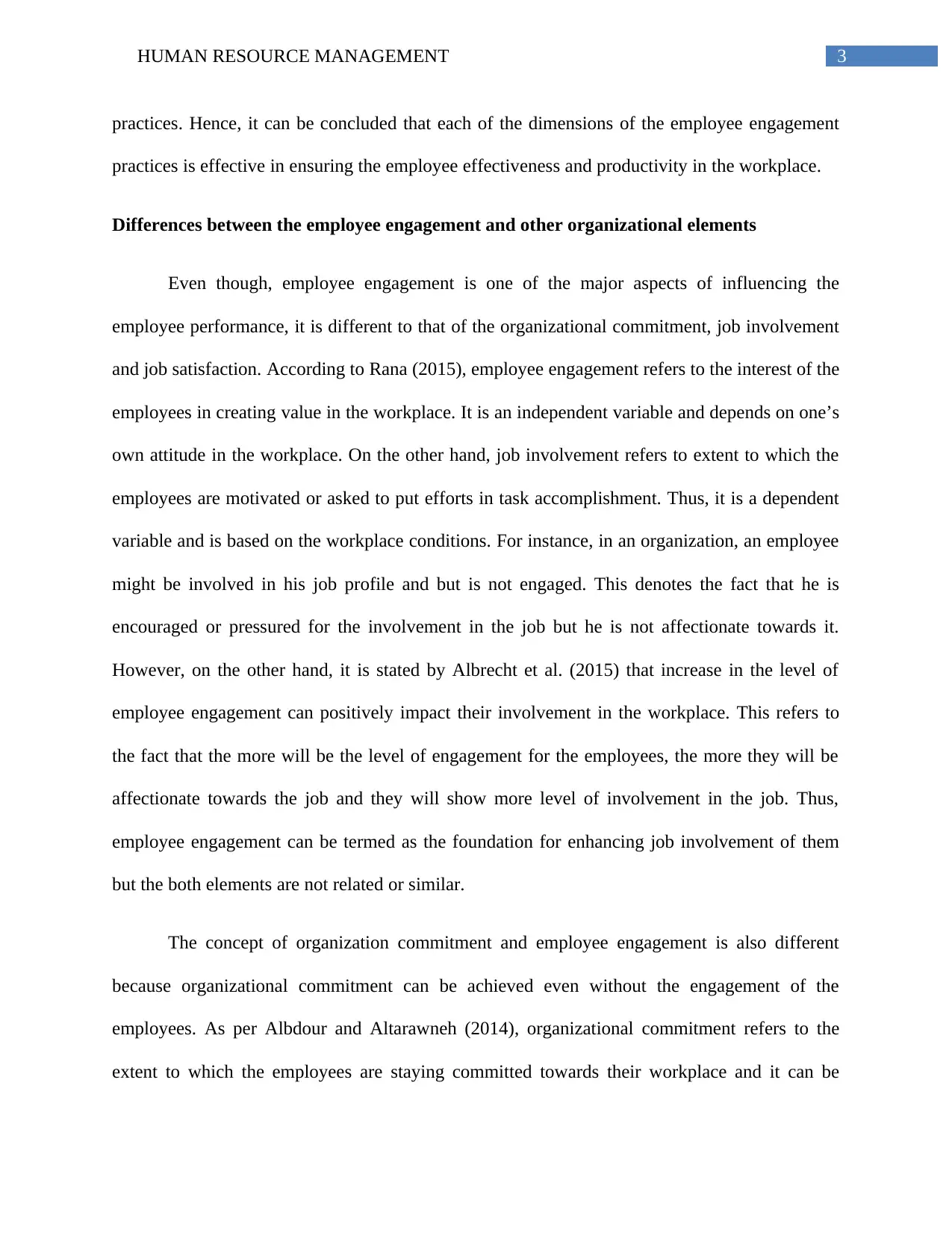
3HUMAN RESOURCE MANAGEMENT
practices. Hence, it can be concluded that each of the dimensions of the employee engagement
practices is effective in ensuring the employee effectiveness and productivity in the workplace.
Differences between the employee engagement and other organizational elements
Even though, employee engagement is one of the major aspects of influencing the
employee performance, it is different to that of the organizational commitment, job involvement
and job satisfaction. According to Rana (2015), employee engagement refers to the interest of the
employees in creating value in the workplace. It is an independent variable and depends on one’s
own attitude in the workplace. On the other hand, job involvement refers to extent to which the
employees are motivated or asked to put efforts in task accomplishment. Thus, it is a dependent
variable and is based on the workplace conditions. For instance, in an organization, an employee
might be involved in his job profile and but is not engaged. This denotes the fact that he is
encouraged or pressured for the involvement in the job but he is not affectionate towards it.
However, on the other hand, it is stated by Albrecht et al. (2015) that increase in the level of
employee engagement can positively impact their involvement in the workplace. This refers to
the fact that the more will be the level of engagement for the employees, the more they will be
affectionate towards the job and they will show more level of involvement in the job. Thus,
employee engagement can be termed as the foundation for enhancing job involvement of them
but the both elements are not related or similar.
The concept of organization commitment and employee engagement is also different
because organizational commitment can be achieved even without the engagement of the
employees. As per Albdour and Altarawneh (2014), organizational commitment refers to the
extent to which the employees are staying committed towards their workplace and it can be
practices. Hence, it can be concluded that each of the dimensions of the employee engagement
practices is effective in ensuring the employee effectiveness and productivity in the workplace.
Differences between the employee engagement and other organizational elements
Even though, employee engagement is one of the major aspects of influencing the
employee performance, it is different to that of the organizational commitment, job involvement
and job satisfaction. According to Rana (2015), employee engagement refers to the interest of the
employees in creating value in the workplace. It is an independent variable and depends on one’s
own attitude in the workplace. On the other hand, job involvement refers to extent to which the
employees are motivated or asked to put efforts in task accomplishment. Thus, it is a dependent
variable and is based on the workplace conditions. For instance, in an organization, an employee
might be involved in his job profile and but is not engaged. This denotes the fact that he is
encouraged or pressured for the involvement in the job but he is not affectionate towards it.
However, on the other hand, it is stated by Albrecht et al. (2015) that increase in the level of
employee engagement can positively impact their involvement in the workplace. This refers to
the fact that the more will be the level of engagement for the employees, the more they will be
affectionate towards the job and they will show more level of involvement in the job. Thus,
employee engagement can be termed as the foundation for enhancing job involvement of them
but the both elements are not related or similar.
The concept of organization commitment and employee engagement is also different
because organizational commitment can be achieved even without the engagement of the
employees. As per Albdour and Altarawneh (2014), organizational commitment refers to the
extent to which the employees are staying committed towards their workplace and it can be
Paraphrase This Document
Need a fresh take? Get an instant paraphrase of this document with our AI Paraphraser
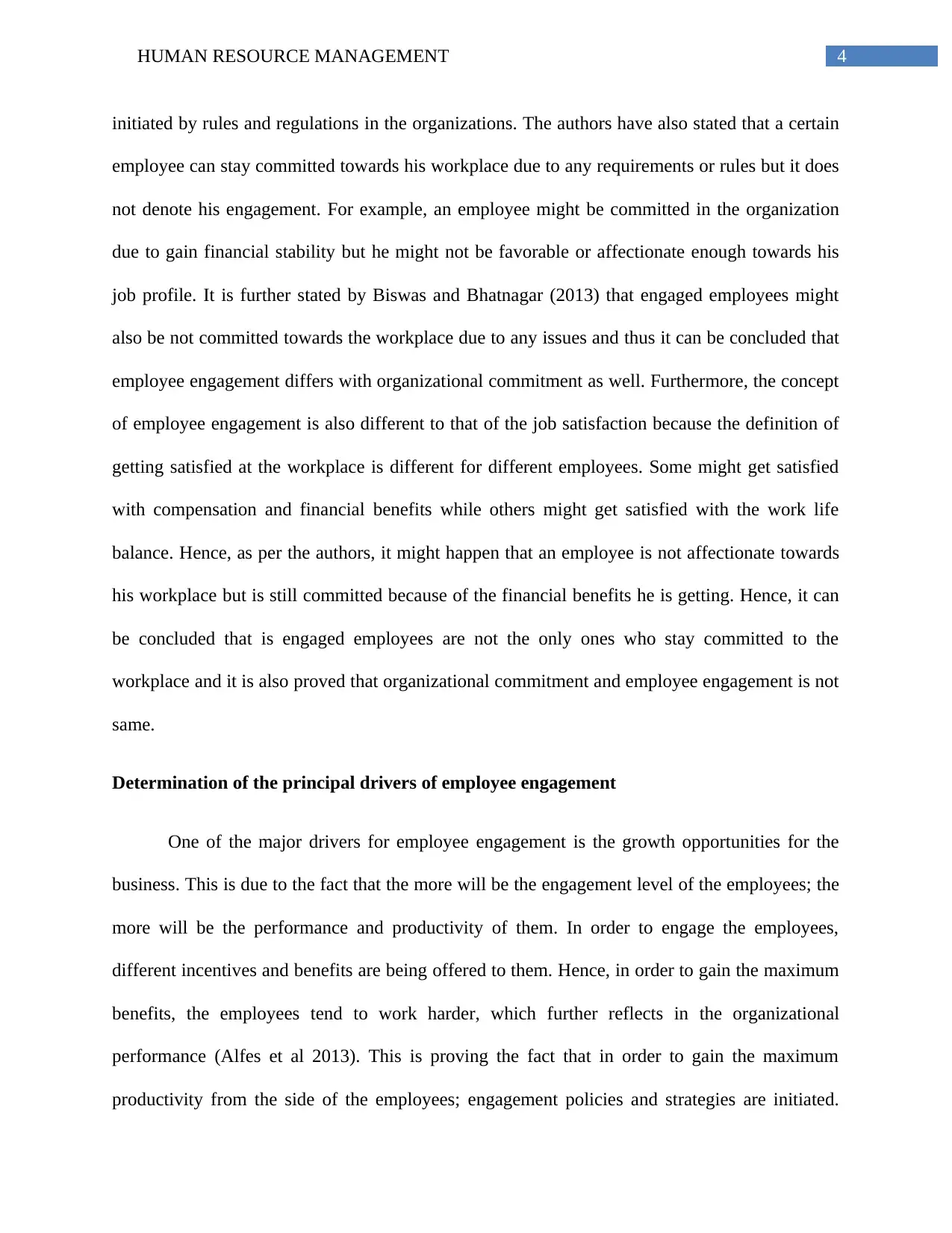
4HUMAN RESOURCE MANAGEMENT
initiated by rules and regulations in the organizations. The authors have also stated that a certain
employee can stay committed towards his workplace due to any requirements or rules but it does
not denote his engagement. For example, an employee might be committed in the organization
due to gain financial stability but he might not be favorable or affectionate enough towards his
job profile. It is further stated by Biswas and Bhatnagar (2013) that engaged employees might
also be not committed towards the workplace due to any issues and thus it can be concluded that
employee engagement differs with organizational commitment as well. Furthermore, the concept
of employee engagement is also different to that of the job satisfaction because the definition of
getting satisfied at the workplace is different for different employees. Some might get satisfied
with compensation and financial benefits while others might get satisfied with the work life
balance. Hence, as per the authors, it might happen that an employee is not affectionate towards
his workplace but is still committed because of the financial benefits he is getting. Hence, it can
be concluded that is engaged employees are not the only ones who stay committed to the
workplace and it is also proved that organizational commitment and employee engagement is not
same.
Determination of the principal drivers of employee engagement
One of the major drivers for employee engagement is the growth opportunities for the
business. This is due to the fact that the more will be the engagement level of the employees; the
more will be the performance and productivity of them. In order to engage the employees,
different incentives and benefits are being offered to them. Hence, in order to gain the maximum
benefits, the employees tend to work harder, which further reflects in the organizational
performance (Alfes et al 2013). This is proving the fact that in order to gain the maximum
productivity from the side of the employees; engagement policies and strategies are initiated.
initiated by rules and regulations in the organizations. The authors have also stated that a certain
employee can stay committed towards his workplace due to any requirements or rules but it does
not denote his engagement. For example, an employee might be committed in the organization
due to gain financial stability but he might not be favorable or affectionate enough towards his
job profile. It is further stated by Biswas and Bhatnagar (2013) that engaged employees might
also be not committed towards the workplace due to any issues and thus it can be concluded that
employee engagement differs with organizational commitment as well. Furthermore, the concept
of employee engagement is also different to that of the job satisfaction because the definition of
getting satisfied at the workplace is different for different employees. Some might get satisfied
with compensation and financial benefits while others might get satisfied with the work life
balance. Hence, as per the authors, it might happen that an employee is not affectionate towards
his workplace but is still committed because of the financial benefits he is getting. Hence, it can
be concluded that is engaged employees are not the only ones who stay committed to the
workplace and it is also proved that organizational commitment and employee engagement is not
same.
Determination of the principal drivers of employee engagement
One of the major drivers for employee engagement is the growth opportunities for the
business. This is due to the fact that the more will be the engagement level of the employees; the
more will be the performance and productivity of them. In order to engage the employees,
different incentives and benefits are being offered to them. Hence, in order to gain the maximum
benefits, the employees tend to work harder, which further reflects in the organizational
performance (Alfes et al 2013). This is proving the fact that in order to gain the maximum
productivity from the side of the employees; engagement policies and strategies are initiated.
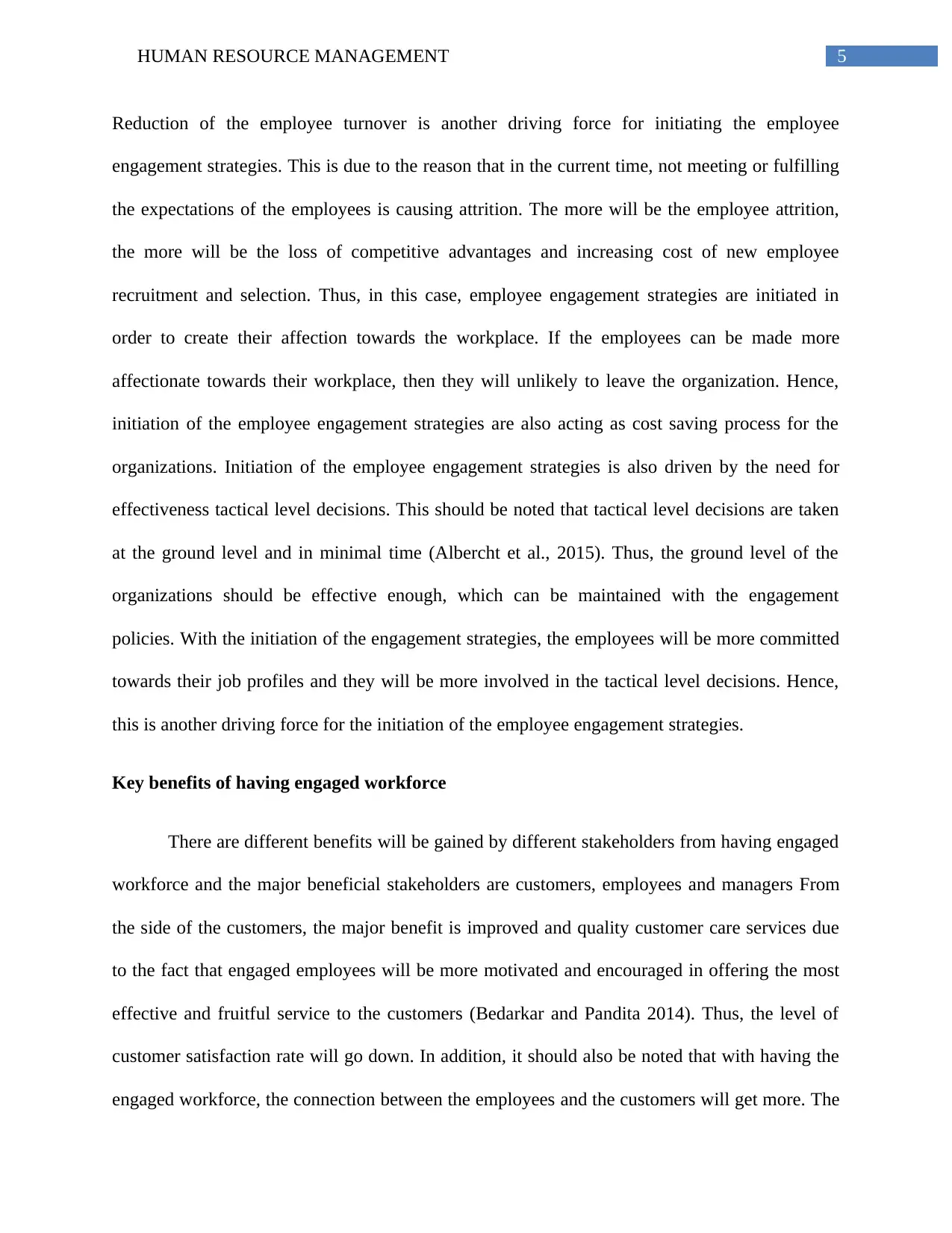
5HUMAN RESOURCE MANAGEMENT
Reduction of the employee turnover is another driving force for initiating the employee
engagement strategies. This is due to the reason that in the current time, not meeting or fulfilling
the expectations of the employees is causing attrition. The more will be the employee attrition,
the more will be the loss of competitive advantages and increasing cost of new employee
recruitment and selection. Thus, in this case, employee engagement strategies are initiated in
order to create their affection towards the workplace. If the employees can be made more
affectionate towards their workplace, then they will unlikely to leave the organization. Hence,
initiation of the employee engagement strategies are also acting as cost saving process for the
organizations. Initiation of the employee engagement strategies is also driven by the need for
effectiveness tactical level decisions. This should be noted that tactical level decisions are taken
at the ground level and in minimal time (Albercht et al., 2015). Thus, the ground level of the
organizations should be effective enough, which can be maintained with the engagement
policies. With the initiation of the engagement strategies, the employees will be more committed
towards their job profiles and they will be more involved in the tactical level decisions. Hence,
this is another driving force for the initiation of the employee engagement strategies.
Key benefits of having engaged workforce
There are different benefits will be gained by different stakeholders from having engaged
workforce and the major beneficial stakeholders are customers, employees and managers From
the side of the customers, the major benefit is improved and quality customer care services due
to the fact that engaged employees will be more motivated and encouraged in offering the most
effective and fruitful service to the customers (Bedarkar and Pandita 2014). Thus, the level of
customer satisfaction rate will go down. In addition, it should also be noted that with having the
engaged workforce, the connection between the employees and the customers will get more. The
Reduction of the employee turnover is another driving force for initiating the employee
engagement strategies. This is due to the reason that in the current time, not meeting or fulfilling
the expectations of the employees is causing attrition. The more will be the employee attrition,
the more will be the loss of competitive advantages and increasing cost of new employee
recruitment and selection. Thus, in this case, employee engagement strategies are initiated in
order to create their affection towards the workplace. If the employees can be made more
affectionate towards their workplace, then they will unlikely to leave the organization. Hence,
initiation of the employee engagement strategies are also acting as cost saving process for the
organizations. Initiation of the employee engagement strategies is also driven by the need for
effectiveness tactical level decisions. This should be noted that tactical level decisions are taken
at the ground level and in minimal time (Albercht et al., 2015). Thus, the ground level of the
organizations should be effective enough, which can be maintained with the engagement
policies. With the initiation of the engagement strategies, the employees will be more committed
towards their job profiles and they will be more involved in the tactical level decisions. Hence,
this is another driving force for the initiation of the employee engagement strategies.
Key benefits of having engaged workforce
There are different benefits will be gained by different stakeholders from having engaged
workforce and the major beneficial stakeholders are customers, employees and managers From
the side of the customers, the major benefit is improved and quality customer care services due
to the fact that engaged employees will be more motivated and encouraged in offering the most
effective and fruitful service to the customers (Bedarkar and Pandita 2014). Thus, the level of
customer satisfaction rate will go down. In addition, it should also be noted that with having the
engaged workforce, the connection between the employees and the customers will get more. The
⊘ This is a preview!⊘
Do you want full access?
Subscribe today to unlock all pages.

Trusted by 1+ million students worldwide
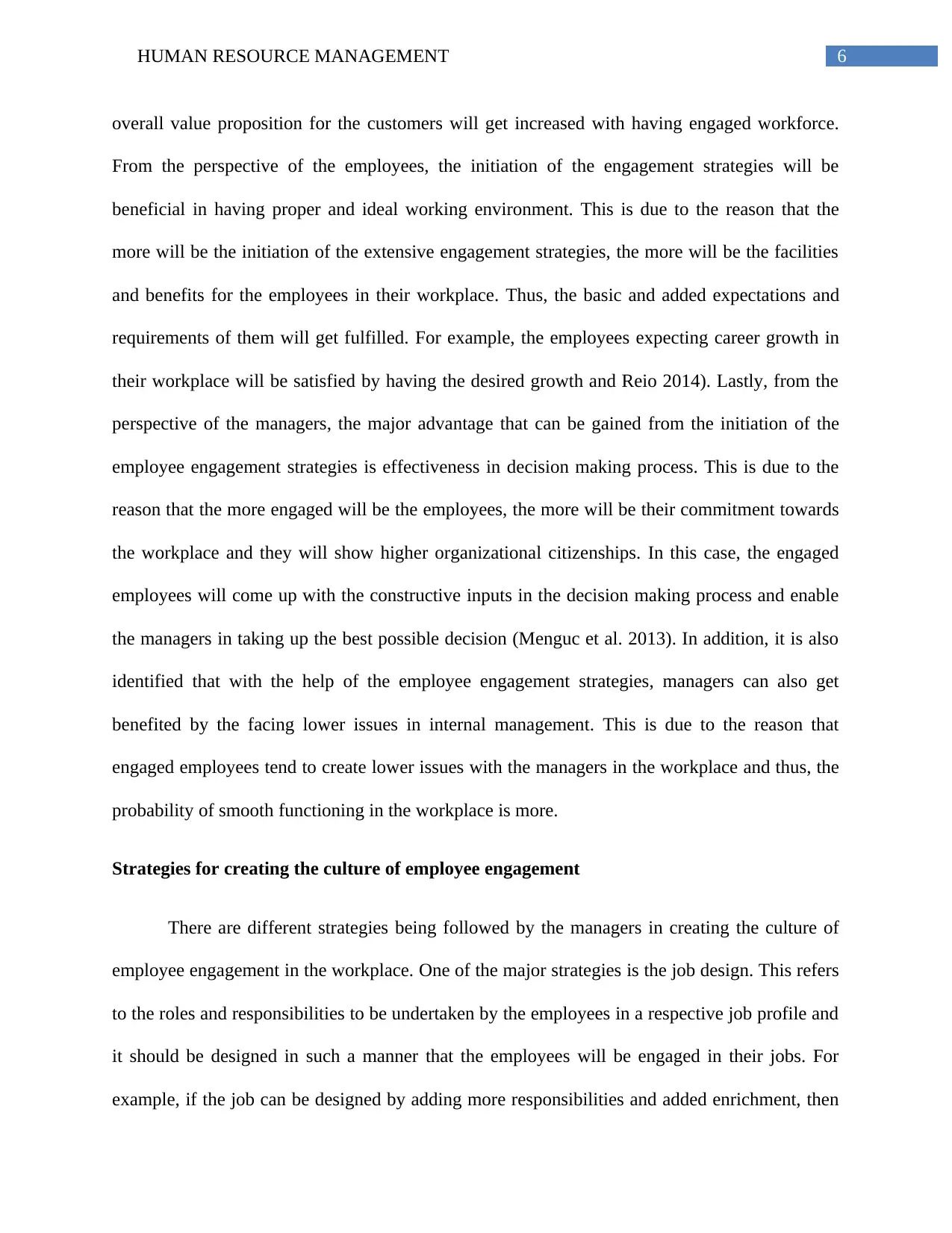
6HUMAN RESOURCE MANAGEMENT
overall value proposition for the customers will get increased with having engaged workforce.
From the perspective of the employees, the initiation of the engagement strategies will be
beneficial in having proper and ideal working environment. This is due to the reason that the
more will be the initiation of the extensive engagement strategies, the more will be the facilities
and benefits for the employees in their workplace. Thus, the basic and added expectations and
requirements of them will get fulfilled. For example, the employees expecting career growth in
their workplace will be satisfied by having the desired growth and Reio 2014). Lastly, from the
perspective of the managers, the major advantage that can be gained from the initiation of the
employee engagement strategies is effectiveness in decision making process. This is due to the
reason that the more engaged will be the employees, the more will be their commitment towards
the workplace and they will show higher organizational citizenships. In this case, the engaged
employees will come up with the constructive inputs in the decision making process and enable
the managers in taking up the best possible decision (Menguc et al. 2013). In addition, it is also
identified that with the help of the employee engagement strategies, managers can also get
benefited by the facing lower issues in internal management. This is due to the reason that
engaged employees tend to create lower issues with the managers in the workplace and thus, the
probability of smooth functioning in the workplace is more.
Strategies for creating the culture of employee engagement
There are different strategies being followed by the managers in creating the culture of
employee engagement in the workplace. One of the major strategies is the job design. This refers
to the roles and responsibilities to be undertaken by the employees in a respective job profile and
it should be designed in such a manner that the employees will be engaged in their jobs. For
example, if the job can be designed by adding more responsibilities and added enrichment, then
overall value proposition for the customers will get increased with having engaged workforce.
From the perspective of the employees, the initiation of the engagement strategies will be
beneficial in having proper and ideal working environment. This is due to the reason that the
more will be the initiation of the extensive engagement strategies, the more will be the facilities
and benefits for the employees in their workplace. Thus, the basic and added expectations and
requirements of them will get fulfilled. For example, the employees expecting career growth in
their workplace will be satisfied by having the desired growth and Reio 2014). Lastly, from the
perspective of the managers, the major advantage that can be gained from the initiation of the
employee engagement strategies is effectiveness in decision making process. This is due to the
reason that the more engaged will be the employees, the more will be their commitment towards
the workplace and they will show higher organizational citizenships. In this case, the engaged
employees will come up with the constructive inputs in the decision making process and enable
the managers in taking up the best possible decision (Menguc et al. 2013). In addition, it is also
identified that with the help of the employee engagement strategies, managers can also get
benefited by the facing lower issues in internal management. This is due to the reason that
engaged employees tend to create lower issues with the managers in the workplace and thus, the
probability of smooth functioning in the workplace is more.
Strategies for creating the culture of employee engagement
There are different strategies being followed by the managers in creating the culture of
employee engagement in the workplace. One of the major strategies is the job design. This refers
to the roles and responsibilities to be undertaken by the employees in a respective job profile and
it should be designed in such a manner that the employees will be engaged in their jobs. For
example, if the job can be designed by adding more responsibilities and added enrichment, then
Paraphrase This Document
Need a fresh take? Get an instant paraphrase of this document with our AI Paraphraser
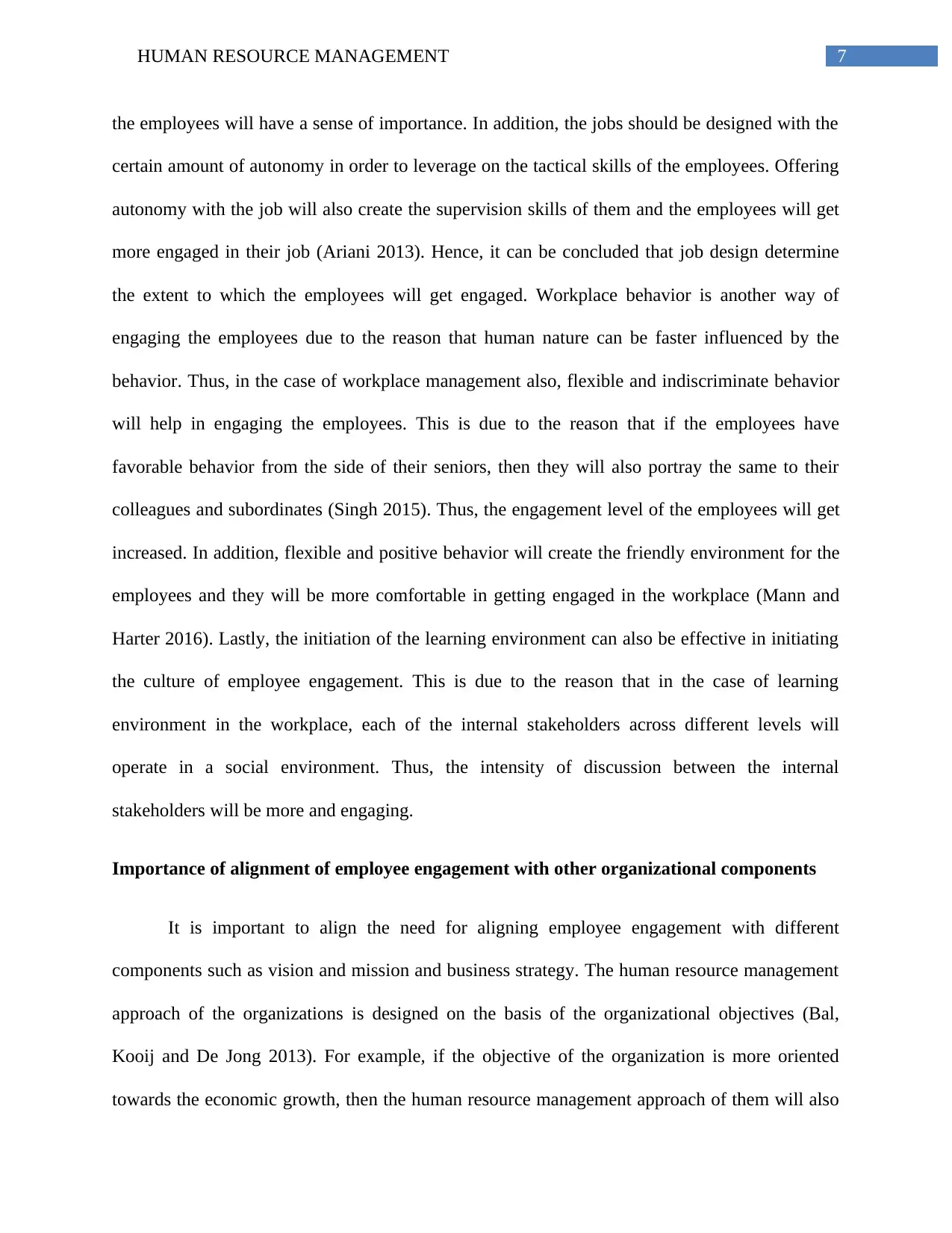
7HUMAN RESOURCE MANAGEMENT
the employees will have a sense of importance. In addition, the jobs should be designed with the
certain amount of autonomy in order to leverage on the tactical skills of the employees. Offering
autonomy with the job will also create the supervision skills of them and the employees will get
more engaged in their job (Ariani 2013). Hence, it can be concluded that job design determine
the extent to which the employees will get engaged. Workplace behavior is another way of
engaging the employees due to the reason that human nature can be faster influenced by the
behavior. Thus, in the case of workplace management also, flexible and indiscriminate behavior
will help in engaging the employees. This is due to the reason that if the employees have
favorable behavior from the side of their seniors, then they will also portray the same to their
colleagues and subordinates (Singh 2015). Thus, the engagement level of the employees will get
increased. In addition, flexible and positive behavior will create the friendly environment for the
employees and they will be more comfortable in getting engaged in the workplace (Mann and
Harter 2016). Lastly, the initiation of the learning environment can also be effective in initiating
the culture of employee engagement. This is due to the reason that in the case of learning
environment in the workplace, each of the internal stakeholders across different levels will
operate in a social environment. Thus, the intensity of discussion between the internal
stakeholders will be more and engaging.
Importance of alignment of employee engagement with other organizational components
It is important to align the need for aligning employee engagement with different
components such as vision and mission and business strategy. The human resource management
approach of the organizations is designed on the basis of the organizational objectives (Bal,
Kooij and De Jong 2013). For example, if the objective of the organization is more oriented
towards the economic growth, then the human resource management approach of them will also
the employees will have a sense of importance. In addition, the jobs should be designed with the
certain amount of autonomy in order to leverage on the tactical skills of the employees. Offering
autonomy with the job will also create the supervision skills of them and the employees will get
more engaged in their job (Ariani 2013). Hence, it can be concluded that job design determine
the extent to which the employees will get engaged. Workplace behavior is another way of
engaging the employees due to the reason that human nature can be faster influenced by the
behavior. Thus, in the case of workplace management also, flexible and indiscriminate behavior
will help in engaging the employees. This is due to the reason that if the employees have
favorable behavior from the side of their seniors, then they will also portray the same to their
colleagues and subordinates (Singh 2015). Thus, the engagement level of the employees will get
increased. In addition, flexible and positive behavior will create the friendly environment for the
employees and they will be more comfortable in getting engaged in the workplace (Mann and
Harter 2016). Lastly, the initiation of the learning environment can also be effective in initiating
the culture of employee engagement. This is due to the reason that in the case of learning
environment in the workplace, each of the internal stakeholders across different levels will
operate in a social environment. Thus, the intensity of discussion between the internal
stakeholders will be more and engaging.
Importance of alignment of employee engagement with other organizational components
It is important to align the need for aligning employee engagement with different
components such as vision and mission and business strategy. The human resource management
approach of the organizations is designed on the basis of the organizational objectives (Bal,
Kooij and De Jong 2013). For example, if the objective of the organization is more oriented
towards the economic growth, then the human resource management approach of them will also
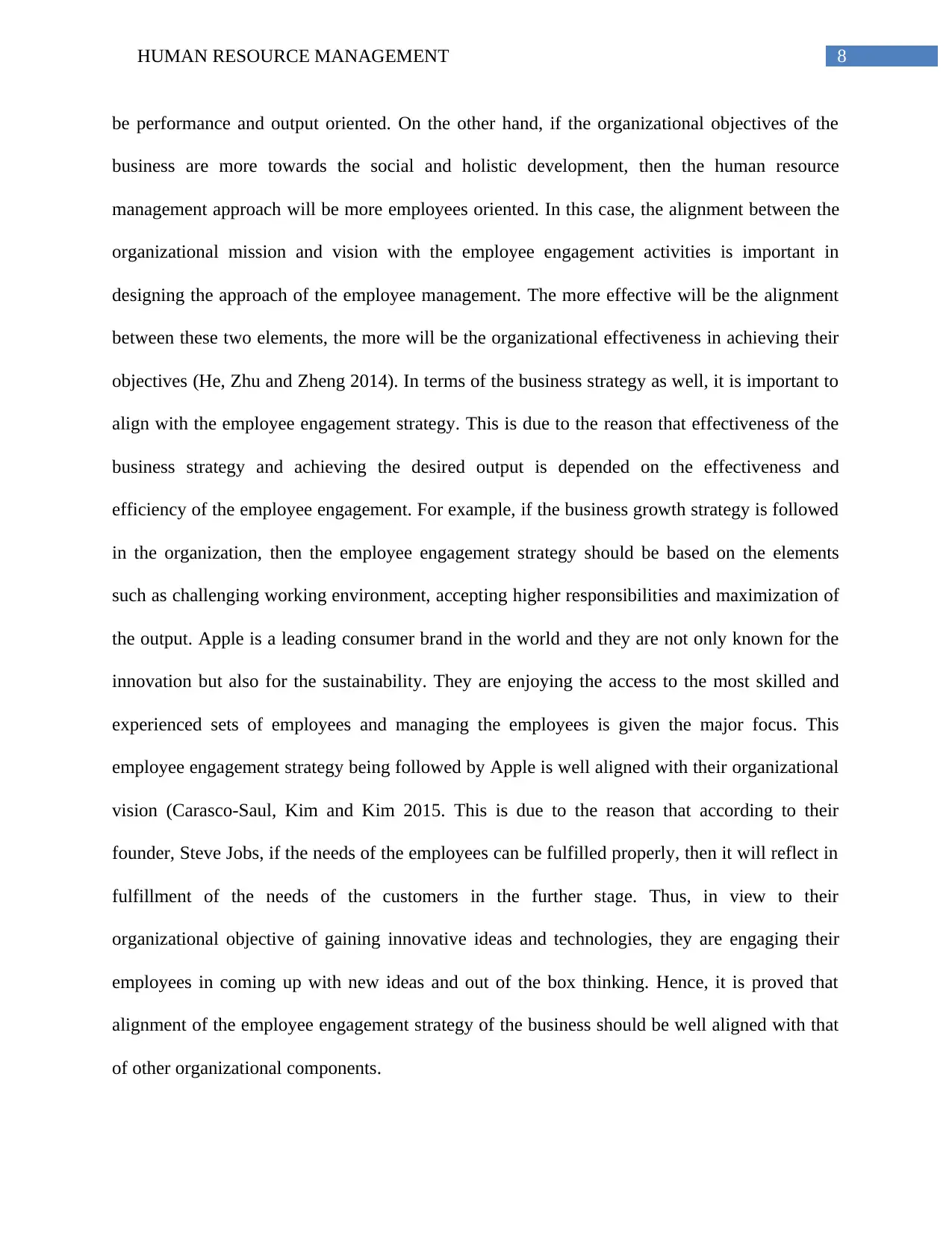
8HUMAN RESOURCE MANAGEMENT
be performance and output oriented. On the other hand, if the organizational objectives of the
business are more towards the social and holistic development, then the human resource
management approach will be more employees oriented. In this case, the alignment between the
organizational mission and vision with the employee engagement activities is important in
designing the approach of the employee management. The more effective will be the alignment
between these two elements, the more will be the organizational effectiveness in achieving their
objectives (He, Zhu and Zheng 2014). In terms of the business strategy as well, it is important to
align with the employee engagement strategy. This is due to the reason that effectiveness of the
business strategy and achieving the desired output is depended on the effectiveness and
efficiency of the employee engagement. For example, if the business growth strategy is followed
in the organization, then the employee engagement strategy should be based on the elements
such as challenging working environment, accepting higher responsibilities and maximization of
the output. Apple is a leading consumer brand in the world and they are not only known for the
innovation but also for the sustainability. They are enjoying the access to the most skilled and
experienced sets of employees and managing the employees is given the major focus. This
employee engagement strategy being followed by Apple is well aligned with their organizational
vision (Carasco-Saul, Kim and Kim 2015. This is due to the reason that according to their
founder, Steve Jobs, if the needs of the employees can be fulfilled properly, then it will reflect in
fulfillment of the needs of the customers in the further stage. Thus, in view to their
organizational objective of gaining innovative ideas and technologies, they are engaging their
employees in coming up with new ideas and out of the box thinking. Hence, it is proved that
alignment of the employee engagement strategy of the business should be well aligned with that
of other organizational components.
be performance and output oriented. On the other hand, if the organizational objectives of the
business are more towards the social and holistic development, then the human resource
management approach will be more employees oriented. In this case, the alignment between the
organizational mission and vision with the employee engagement activities is important in
designing the approach of the employee management. The more effective will be the alignment
between these two elements, the more will be the organizational effectiveness in achieving their
objectives (He, Zhu and Zheng 2014). In terms of the business strategy as well, it is important to
align with the employee engagement strategy. This is due to the reason that effectiveness of the
business strategy and achieving the desired output is depended on the effectiveness and
efficiency of the employee engagement. For example, if the business growth strategy is followed
in the organization, then the employee engagement strategy should be based on the elements
such as challenging working environment, accepting higher responsibilities and maximization of
the output. Apple is a leading consumer brand in the world and they are not only known for the
innovation but also for the sustainability. They are enjoying the access to the most skilled and
experienced sets of employees and managing the employees is given the major focus. This
employee engagement strategy being followed by Apple is well aligned with their organizational
vision (Carasco-Saul, Kim and Kim 2015. This is due to the reason that according to their
founder, Steve Jobs, if the needs of the employees can be fulfilled properly, then it will reflect in
fulfillment of the needs of the customers in the further stage. Thus, in view to their
organizational objective of gaining innovative ideas and technologies, they are engaging their
employees in coming up with new ideas and out of the box thinking. Hence, it is proved that
alignment of the employee engagement strategy of the business should be well aligned with that
of other organizational components.
⊘ This is a preview!⊘
Do you want full access?
Subscribe today to unlock all pages.

Trusted by 1+ million students worldwide
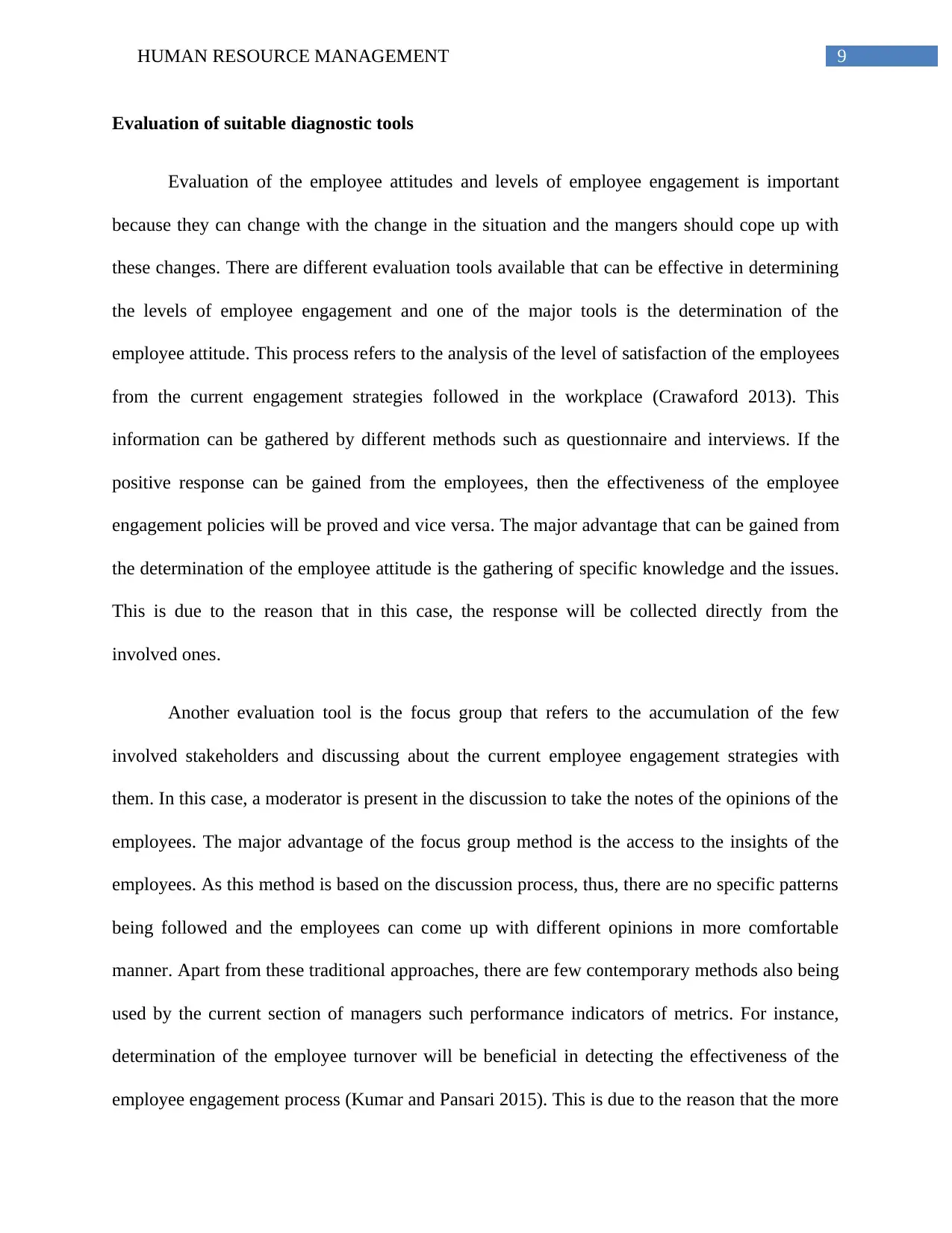
9HUMAN RESOURCE MANAGEMENT
Evaluation of suitable diagnostic tools
Evaluation of the employee attitudes and levels of employee engagement is important
because they can change with the change in the situation and the mangers should cope up with
these changes. There are different evaluation tools available that can be effective in determining
the levels of employee engagement and one of the major tools is the determination of the
employee attitude. This process refers to the analysis of the level of satisfaction of the employees
from the current engagement strategies followed in the workplace (Crawaford 2013). This
information can be gathered by different methods such as questionnaire and interviews. If the
positive response can be gained from the employees, then the effectiveness of the employee
engagement policies will be proved and vice versa. The major advantage that can be gained from
the determination of the employee attitude is the gathering of specific knowledge and the issues.
This is due to the reason that in this case, the response will be collected directly from the
involved ones.
Another evaluation tool is the focus group that refers to the accumulation of the few
involved stakeholders and discussing about the current employee engagement strategies with
them. In this case, a moderator is present in the discussion to take the notes of the opinions of the
employees. The major advantage of the focus group method is the access to the insights of the
employees. As this method is based on the discussion process, thus, there are no specific patterns
being followed and the employees can come up with different opinions in more comfortable
manner. Apart from these traditional approaches, there are few contemporary methods also being
used by the current section of managers such performance indicators of metrics. For instance,
determination of the employee turnover will be beneficial in detecting the effectiveness of the
employee engagement process (Kumar and Pansari 2015). This is due to the reason that the more
Evaluation of suitable diagnostic tools
Evaluation of the employee attitudes and levels of employee engagement is important
because they can change with the change in the situation and the mangers should cope up with
these changes. There are different evaluation tools available that can be effective in determining
the levels of employee engagement and one of the major tools is the determination of the
employee attitude. This process refers to the analysis of the level of satisfaction of the employees
from the current engagement strategies followed in the workplace (Crawaford 2013). This
information can be gathered by different methods such as questionnaire and interviews. If the
positive response can be gained from the employees, then the effectiveness of the employee
engagement policies will be proved and vice versa. The major advantage that can be gained from
the determination of the employee attitude is the gathering of specific knowledge and the issues.
This is due to the reason that in this case, the response will be collected directly from the
involved ones.
Another evaluation tool is the focus group that refers to the accumulation of the few
involved stakeholders and discussing about the current employee engagement strategies with
them. In this case, a moderator is present in the discussion to take the notes of the opinions of the
employees. The major advantage of the focus group method is the access to the insights of the
employees. As this method is based on the discussion process, thus, there are no specific patterns
being followed and the employees can come up with different opinions in more comfortable
manner. Apart from these traditional approaches, there are few contemporary methods also being
used by the current section of managers such performance indicators of metrics. For instance,
determination of the employee turnover will be beneficial in detecting the effectiveness of the
employee engagement process (Kumar and Pansari 2015). This is due to the reason that the more
Paraphrase This Document
Need a fresh take? Get an instant paraphrase of this document with our AI Paraphraser
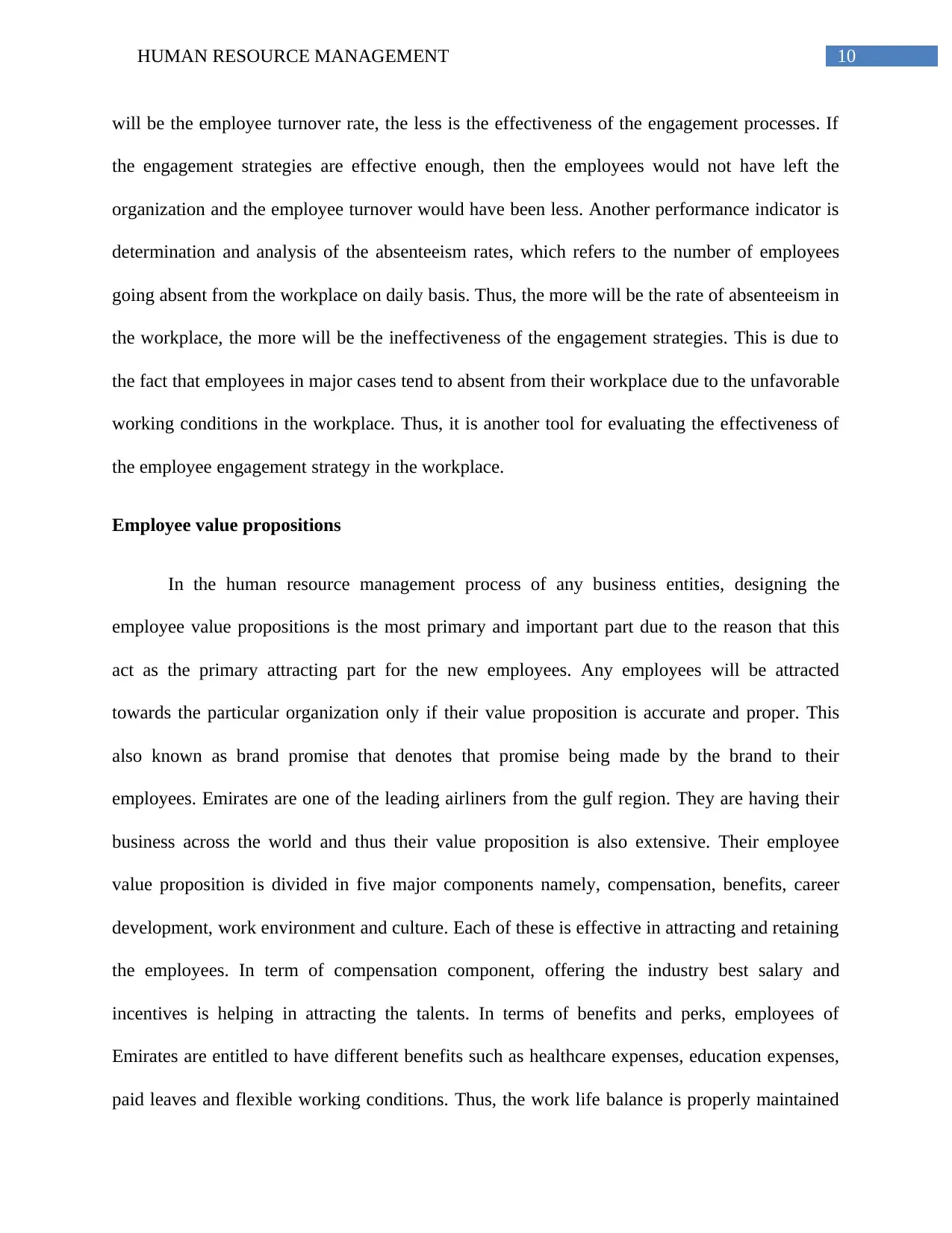
10HUMAN RESOURCE MANAGEMENT
will be the employee turnover rate, the less is the effectiveness of the engagement processes. If
the engagement strategies are effective enough, then the employees would not have left the
organization and the employee turnover would have been less. Another performance indicator is
determination and analysis of the absenteeism rates, which refers to the number of employees
going absent from the workplace on daily basis. Thus, the more will be the rate of absenteeism in
the workplace, the more will be the ineffectiveness of the engagement strategies. This is due to
the fact that employees in major cases tend to absent from their workplace due to the unfavorable
working conditions in the workplace. Thus, it is another tool for evaluating the effectiveness of
the employee engagement strategy in the workplace.
Employee value propositions
In the human resource management process of any business entities, designing the
employee value propositions is the most primary and important part due to the reason that this
act as the primary attracting part for the new employees. Any employees will be attracted
towards the particular organization only if their value proposition is accurate and proper. This
also known as brand promise that denotes that promise being made by the brand to their
employees. Emirates are one of the leading airliners from the gulf region. They are having their
business across the world and thus their value proposition is also extensive. Their employee
value proposition is divided in five major components namely, compensation, benefits, career
development, work environment and culture. Each of these is effective in attracting and retaining
the employees. In term of compensation component, offering the industry best salary and
incentives is helping in attracting the talents. In terms of benefits and perks, employees of
Emirates are entitled to have different benefits such as healthcare expenses, education expenses,
paid leaves and flexible working conditions. Thus, the work life balance is properly maintained
will be the employee turnover rate, the less is the effectiveness of the engagement processes. If
the engagement strategies are effective enough, then the employees would not have left the
organization and the employee turnover would have been less. Another performance indicator is
determination and analysis of the absenteeism rates, which refers to the number of employees
going absent from the workplace on daily basis. Thus, the more will be the rate of absenteeism in
the workplace, the more will be the ineffectiveness of the engagement strategies. This is due to
the fact that employees in major cases tend to absent from their workplace due to the unfavorable
working conditions in the workplace. Thus, it is another tool for evaluating the effectiveness of
the employee engagement strategy in the workplace.
Employee value propositions
In the human resource management process of any business entities, designing the
employee value propositions is the most primary and important part due to the reason that this
act as the primary attracting part for the new employees. Any employees will be attracted
towards the particular organization only if their value proposition is accurate and proper. This
also known as brand promise that denotes that promise being made by the brand to their
employees. Emirates are one of the leading airliners from the gulf region. They are having their
business across the world and thus their value proposition is also extensive. Their employee
value proposition is divided in five major components namely, compensation, benefits, career
development, work environment and culture. Each of these is effective in attracting and retaining
the employees. In term of compensation component, offering the industry best salary and
incentives is helping in attracting the talents. In terms of benefits and perks, employees of
Emirates are entitled to have different benefits such as healthcare expenses, education expenses,
paid leaves and flexible working conditions. Thus, the work life balance is properly maintained
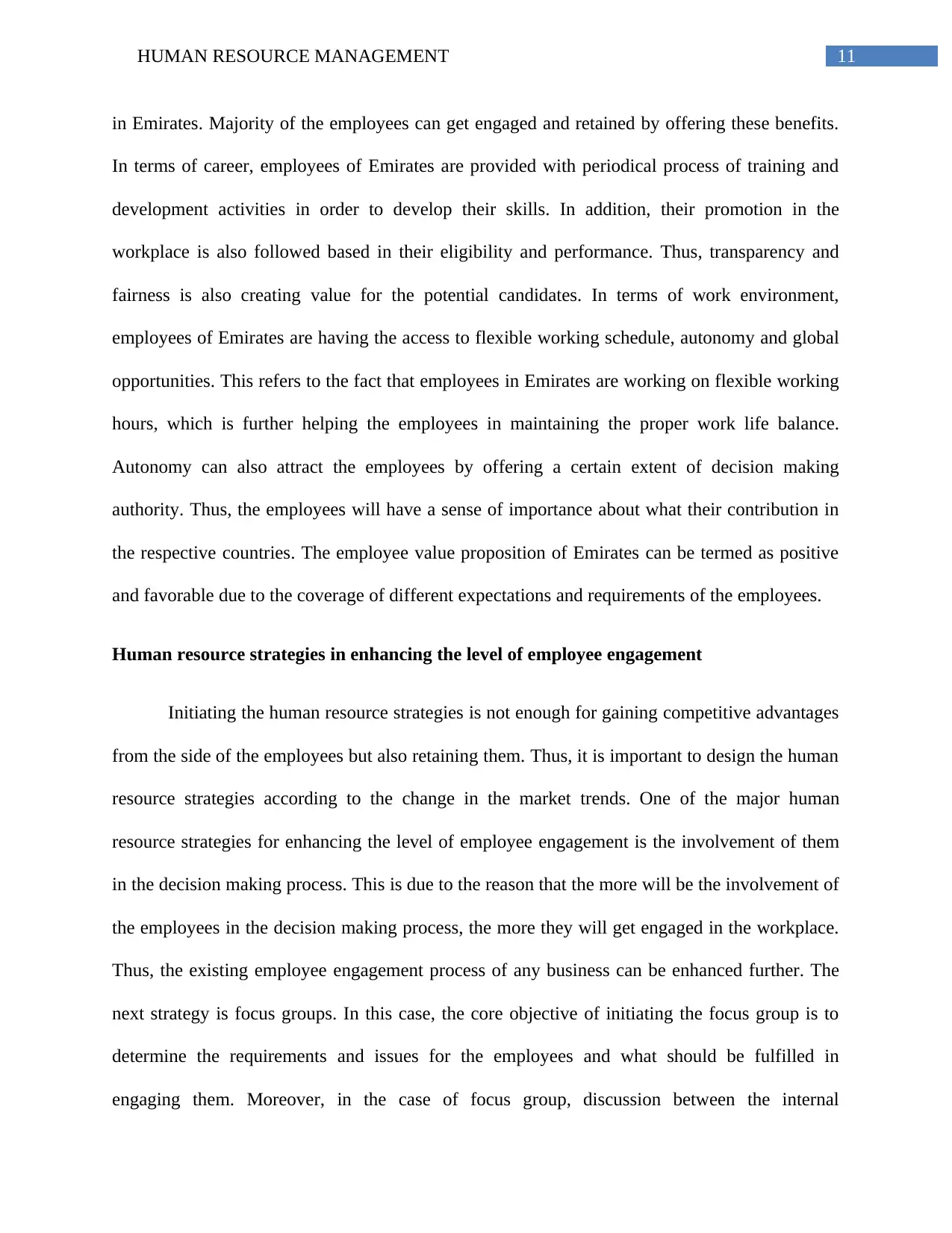
11HUMAN RESOURCE MANAGEMENT
in Emirates. Majority of the employees can get engaged and retained by offering these benefits.
In terms of career, employees of Emirates are provided with periodical process of training and
development activities in order to develop their skills. In addition, their promotion in the
workplace is also followed based in their eligibility and performance. Thus, transparency and
fairness is also creating value for the potential candidates. In terms of work environment,
employees of Emirates are having the access to flexible working schedule, autonomy and global
opportunities. This refers to the fact that employees in Emirates are working on flexible working
hours, which is further helping the employees in maintaining the proper work life balance.
Autonomy can also attract the employees by offering a certain extent of decision making
authority. Thus, the employees will have a sense of importance about what their contribution in
the respective countries. The employee value proposition of Emirates can be termed as positive
and favorable due to the coverage of different expectations and requirements of the employees.
Human resource strategies in enhancing the level of employee engagement
Initiating the human resource strategies is not enough for gaining competitive advantages
from the side of the employees but also retaining them. Thus, it is important to design the human
resource strategies according to the change in the market trends. One of the major human
resource strategies for enhancing the level of employee engagement is the involvement of them
in the decision making process. This is due to the reason that the more will be the involvement of
the employees in the decision making process, the more they will get engaged in the workplace.
Thus, the existing employee engagement process of any business can be enhanced further. The
next strategy is focus groups. In this case, the core objective of initiating the focus group is to
determine the requirements and issues for the employees and what should be fulfilled in
engaging them. Moreover, in the case of focus group, discussion between the internal
in Emirates. Majority of the employees can get engaged and retained by offering these benefits.
In terms of career, employees of Emirates are provided with periodical process of training and
development activities in order to develop their skills. In addition, their promotion in the
workplace is also followed based in their eligibility and performance. Thus, transparency and
fairness is also creating value for the potential candidates. In terms of work environment,
employees of Emirates are having the access to flexible working schedule, autonomy and global
opportunities. This refers to the fact that employees in Emirates are working on flexible working
hours, which is further helping the employees in maintaining the proper work life balance.
Autonomy can also attract the employees by offering a certain extent of decision making
authority. Thus, the employees will have a sense of importance about what their contribution in
the respective countries. The employee value proposition of Emirates can be termed as positive
and favorable due to the coverage of different expectations and requirements of the employees.
Human resource strategies in enhancing the level of employee engagement
Initiating the human resource strategies is not enough for gaining competitive advantages
from the side of the employees but also retaining them. Thus, it is important to design the human
resource strategies according to the change in the market trends. One of the major human
resource strategies for enhancing the level of employee engagement is the involvement of them
in the decision making process. This is due to the reason that the more will be the involvement of
the employees in the decision making process, the more they will get engaged in the workplace.
Thus, the existing employee engagement process of any business can be enhanced further. The
next strategy is focus groups. In this case, the core objective of initiating the focus group is to
determine the requirements and issues for the employees and what should be fulfilled in
engaging them. Moreover, in the case of focus group, discussion between the internal
⊘ This is a preview!⊘
Do you want full access?
Subscribe today to unlock all pages.

Trusted by 1+ million students worldwide
1 out of 17
Related Documents
Your All-in-One AI-Powered Toolkit for Academic Success.
+13062052269
info@desklib.com
Available 24*7 on WhatsApp / Email
![[object Object]](/_next/static/media/star-bottom.7253800d.svg)
Unlock your academic potential
Copyright © 2020–2025 A2Z Services. All Rights Reserved. Developed and managed by ZUCOL.




